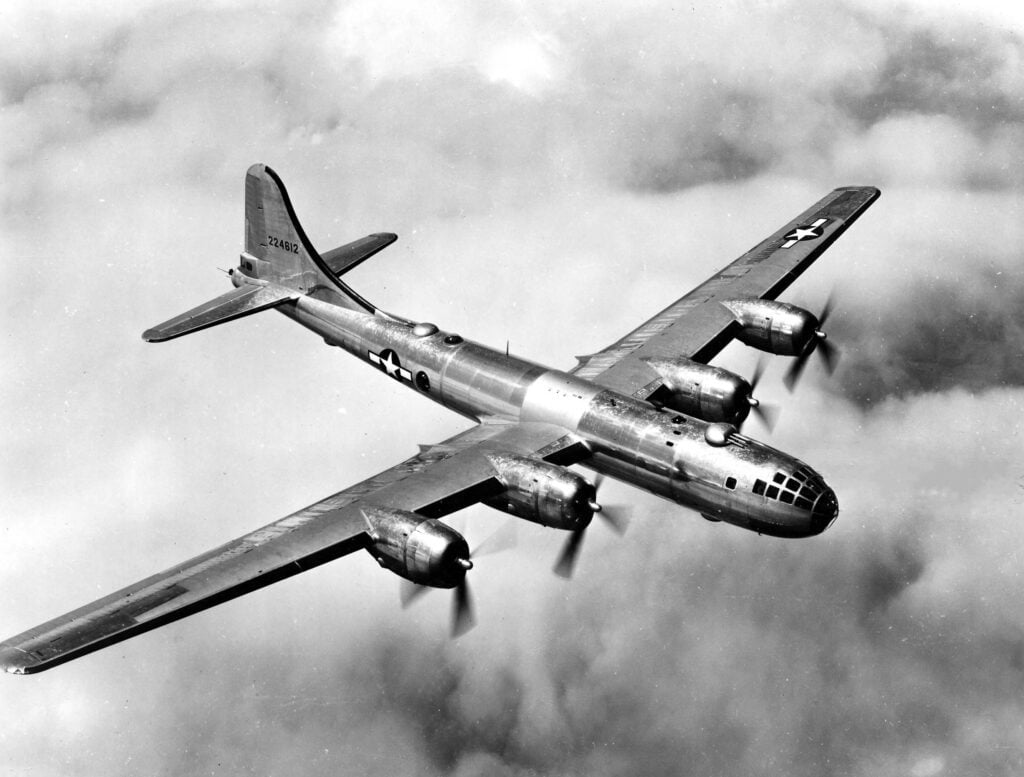The B-29 was one of the most technologically advanced planes during World War II. It had several innovative technologies such as remote-controlled weapons. Crewmen could also crawl between the fore and aft crew areas, which were pressurized and connected by a long tube over the bomb bays. With such an advanced flying machine, it would make you wonder how much did the United States pay to have it made.
The B-29 Superfortressees were the planes used to drop the Atomic Bombs. It took $3 billion to develop. The bombs only cost The Manhattan Project $1.9 billion to make. Meaning the planes were more expensive than the bombs themselves.
The Development and Production of the B-29 Superfortress
The US Army Air Corps claimed that the B-29 Superfortress would be the primary strategic bomber for the United States during World War II. Still, they assessed that it would be in short supply for the Pacific Theater, which required a bomber capable of transmitting a larger payload over 3,000 miles. Boeing began developing pressurized long-array bombers in response to this conclusion.
In 1939, Charles Lindbergh urged General Henry H. Arnold to produce a new bomber in large numbers to compete with German production. The Air Corps issued a formal super bomber specification the same year, capable of transporting about 20,000 pounds of bombs to a target 4,292 kilometers away at a top speed of 640 kilometers per hour.
Externally, all models of the Boeing B-29 Superfortress looked identical. However, they differ in the built wing center areas, which are influenced by the wingspan size. (Source: The Pacific War Online Encyclopedia)
Notable Incidents Involving the B-29 Superfortress
In 1944, the crash of the Boeing B-29 Superfortress was reported near Clovis, Mexico. Based on the report, fifteen crew members were killed during the incident. Another accident involving the B-29 was reported six years later. The Boeing B-29 Superfortress departed the Air Force Base of Kirtland and crashed into a mountain a few minutes after its take-off. And another incident was when a Superfortress fell into an uptown location in California in 1950. According to the news, 17 people were killed, and 68 others were injured in the tragedy. (Source: The Pacific War Online Encyclopedia)
The Weapon That Made Japan Surrender
During World War II, some B-29 Superfortresses were deployed mainly in the Pacific theater, with up to 1,000 Superfortresses bombing Tokyo at a time, devastating vast portions of the city.
Finally, the B-29 named Enola Gay delivered the world’s first atomic bomb on Hiroshima, Japan, on August 6, 1945. Bockscar, a second B-29 bomber, detonated another Atomic bomb on Nagasaki; three days later. At this point, Japan had surrendered to the United States. After the war, B-29s were adapted for several functions, including in-flight refueling, antisubmarine patrol, weather reconnaissance, and rescue duty. (Source: The Pacific War Online Encyclopedia)
Are There Still B-29 Superfortresses?
There are twenty-two B-29 Superfortresses preserved in different museums around the world. There are two of which are still used as flying examples. The FIFI belongs to the Commemorative Airforce and Doc which belongs to Doc’s Friends in Witchita, Kansas. But none of these planes are commissioned to do any actual work. (Source: The Witchita Eagle)
